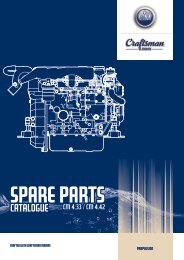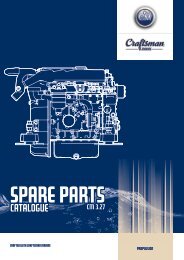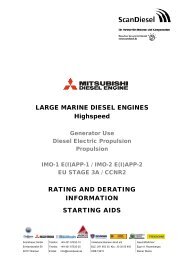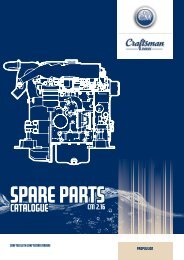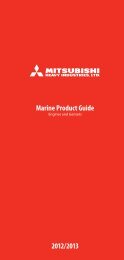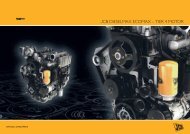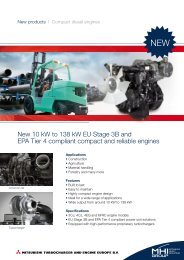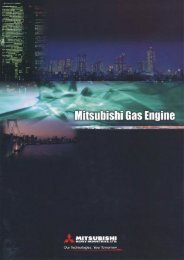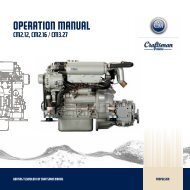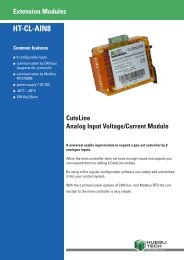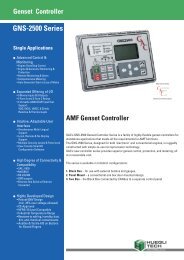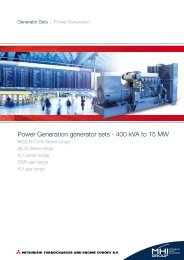CM4.65 & CM4.80 - Craftsman Marine BV
CM4.65 & CM4.80 - Craftsman Marine BV
CM4.65 & CM4.80 - Craftsman Marine BV
You also want an ePaper? Increase the reach of your titles
YUMPU automatically turns print PDFs into web optimized ePapers that Google loves.
<strong>CM4.65</strong><br />
& <strong>CM4.80</strong><br />
Engine manual<br />
Crafted with craftsman marine<br />
Propulsion
Preface<br />
Safety<br />
Dear owner of this engine,<br />
We would like to thank you very much for your decision to procure a marine diesel<br />
engine, made by <strong>Craftsman</strong> <strong>Marine</strong>.<br />
Provided you will make proper use of it and take care of adequate maintenance, this<br />
engine will serve you faithfully and trouble-free, for many years to come.<br />
This instruction manual informs you about the control, the maintenance and the<br />
inspection of the <strong>Craftsman</strong> <strong>Marine</strong> diesel engines, models <strong>CM4.65</strong> and <strong>CM4.80</strong>.<br />
Please store this manual in an accessible place.<br />
Should you have any further questions after having read this manual, we shall be<br />
delighted to be of service.<br />
<strong>Craftsman</strong> <strong>Marine</strong> B.V.<br />
This page will provide you with a survey of all warning pictograms, used throughout<br />
this manual. Notes referring to safety issues show this symbol:<br />
DANGER<br />
ATTENTION<br />
Please adhere strictly to the recommendations in this chapter and instruct anybody<br />
else, who may be operating or servicing the engine, to do likewise. These are the<br />
safety recommendations:<br />
• Never touch any moving parts when the engine is running.<br />
• When in operation the engine (or certain parts thereof) may becomevery hot.<br />
Do not ever touch these parts and be very careful with flammable products in the<br />
neighbourhood of the engine.<br />
• When checking upon or adjusting any parts, or when checking or filling<br />
lubricants or cooling liquids, make sure that the engine is stopped.<br />
• Do not open the filler cap on the expansion tank or on the heat exchanger unless<br />
the engine is completely cooled down.<br />
• Maintenance and service to the engine must only be provided by experienced<br />
people, using suitable tools. If possible entrust only an authorized <strong>Craftsman</strong><br />
<strong>Marine</strong> dealer to do such work.<br />
Pay attention to the symbols and read the instructions in the<br />
text.<br />
Attention<br />
(especially with a view to a safety risk for man or material)<br />
Crafted with CRAFTSMAN MARINE<br />
3
Note:<br />
This manual applies to model <strong>CM4.65</strong> and model <strong>CM4.80</strong>. Therefore, it can happen<br />
that a drawing or picture is not always an exact referral to the engine that you have<br />
purchased. Please read this manual carefully before commissioning the engine.<br />
Improper use of this engine may cause accidents and all warranty conditions may<br />
become invalid.<br />
In this manual you will also find detailed instructions of how and how regularly the<br />
various components of your engine must be serviced. This engine must be used<br />
exclusively in accordance with the prescription given in the General Conditions of<br />
Sale and Supply.<br />
In the case of deviating use the manufacturer does not accept any responsibility<br />
whatsoever for resulting damage. This type of risk is to be borne exclusively by the<br />
user.<br />
Correct and proper use also implies strictly adhering to the prescriptions of<br />
operation, maintenance and repair. Only such persons, who are acquainted with the<br />
operation, the maintenance and the repair of your engine, and who are fully aware of<br />
any danger involved, should be allowed to work at your engine.<br />
For that reason, always have your engine serviced, maintained and repaired by an<br />
authorized CRAFTSMAN MARINE dealer.<br />
In the case of modifications of the engine, which have not been previously approved<br />
by <strong>Craftsman</strong> <strong>Marine</strong> in writing, the responsibility of the manufacturer for any<br />
resulting damage is immediately rendered null and void.<br />
Modifications of the injection and distribution system also form part of the aforementioned<br />
exclusion of the manufacturer’s warranty. Moreover, they may affect the<br />
performance of the engine and the exhaust gas emission in a negative fashion.<br />
It may be possible that the fulfillment of the legal prescriptions regarding the<br />
emission of exhaust gases, aiming at the protection of the environment, is no longer<br />
guaranteed in that case.<br />
Disclaimer<br />
The specifications and the descriptions in this instruction manual were correct at the time of going to press. However, <strong>Craftsman</strong> <strong>Marine</strong> is continuously striving after the<br />
improvement of its products and therefore reserves the right to modify – at all times and without prior notification - product specifications and instruction manuals.<br />
4 Crafted with CRAFTSMAN MARINE
Table of contents<br />
1<br />
2<br />
3<br />
4<br />
Safety<br />
Disclaimer<br />
Product identification<br />
Product description<br />
Service side<br />
Starter motor side<br />
Standard scope of supply<br />
Prior to commissioning the engine<br />
Engine lubrication oil<br />
Gearbox<br />
Cooling liquid<br />
Instrument panel<br />
3<br />
4<br />
7<br />
8<br />
8<br />
9<br />
10<br />
11<br />
11<br />
12<br />
13<br />
14<br />
8<br />
9<br />
10<br />
Maintenance and inspection<br />
Topping up the lubrication oil<br />
Changing of the engine lubrication oil<br />
Replacing the oil filter<br />
Adding new oil<br />
Checking of oil level in gearbox<br />
Check-up of coolant level<br />
Replace cooling liquid<br />
Check-up of raw water pump impeller<br />
Impeller removal<br />
Checking of the cooling water strainer<br />
Replacing the fuel filter<br />
Draining of the water separator/fuel filter<br />
Inspection of the V-belt<br />
Winter storage<br />
Preparations for the new season<br />
20<br />
20<br />
21<br />
21<br />
21<br />
22<br />
23<br />
23<br />
24<br />
24<br />
25<br />
26<br />
27<br />
29<br />
30<br />
32<br />
5<br />
Engine operation<br />
First check<br />
The starting procedure<br />
Monitoring lights oil pressure and battery<br />
charging current<br />
Electric engine stop<br />
16<br />
16<br />
16<br />
17<br />
17<br />
11<br />
12<br />
13<br />
Problems and solutions<br />
Technical data<br />
Overall Dimensions<br />
<strong>CM4.80</strong> with ZF25 Gearbox<br />
<strong>CM4.65</strong> with TM345 Gearbox<br />
34<br />
38<br />
40<br />
40<br />
41<br />
6<br />
Calorifier installation<br />
18<br />
14<br />
Lubricants and cooling liquids<br />
42<br />
7<br />
Maintenance schedule<br />
19<br />
Crafted with CRAFTSMAN MARINE<br />
5
Notes<br />
6 Crafted with CRAFTSMAN MARINE
Product identification 1<br />
Identification tag Position of the identification tag Hyundai engine serial number<br />
The <strong>Craftsman</strong> <strong>Marine</strong> identification tag is the place to<br />
find the engine model, the serial number and a few<br />
more data concerning your engine.<br />
Please make sure this information is correctly noted in<br />
the service and warranty book.<br />
The <strong>Craftsman</strong> <strong>Marine</strong> identification tag is located on<br />
top of the rocker cover, next to the oil filler cap.<br />
The Hyundai engine serial number is engraved into the<br />
engine block to the starboard side and into the flywheel<br />
housing.<br />
You will need this information if and<br />
when you have to order spare parts, or<br />
if you want to correspond with our<br />
service department.<br />
Crafted with CRAFTSMAN MARINE<br />
7
2 Product description Service side<br />
Drain plug internal cooling<br />
system<br />
Drain valve internal cooling<br />
system<br />
Heat exchanger<br />
Air inlet silencer<br />
Alternator<br />
V-Belt<br />
Exhaust injection bend<br />
( Ø 60 / Ø 75 mm)<br />
Oil filter<br />
Raw water pump<br />
( Ø 28 mm )<br />
Engine Oil Cooler<br />
8 Crafted with CRAFTSMAN MARINE
Starter motor side<br />
Product description<br />
2<br />
Oil filter cap<br />
Filler cap inner cooling circuit<br />
Connections of<br />
electrical system &<br />
fuse<br />
Fuel filter<br />
Connection to fuel<br />
supply (Ø 8 mm)<br />
Fuel supply pump<br />
Starter motor<br />
Crafted with CRAFTSMAN MARINE<br />
9
3<br />
Standard scope of supply<br />
• Engine instrument panel<br />
• Engine cable loom with fuse and Multi-plugs<br />
• Connection parts for the push-pull cables<br />
• Four flexible engine mountings<br />
• Sump pump<br />
By carefully adhering to the following recommendations, you will be sure of the best<br />
possible conditions to operate your engine, resulting in a long life span, excellent<br />
performance and fuel economy.<br />
(optional):<br />
• Fuel filter/water separator in the fuel supply line (recommended)<br />
For an optional list of supply list take a look at our website<br />
www.craftsmanmarine.com<br />
• Have the maintenance procedures regularly executed, as mentioned in this<br />
manual.<br />
• Prior to starting the engine, always verify the correct level of the various fluids.<br />
• All year long, use a good quality anti-freeze product, protecting your engine<br />
against corrosion and frost damage. Please see page 41 for the specifications of<br />
the cooling liquid.<br />
• Do not ever put the engine into operation without a properly functioning<br />
thermostat, so as to avoid overheating of the engine.<br />
• Always use the correct quality of lubricants, as specified on page 11 of this<br />
manual.<br />
• Always use good quality diesel fuel, free from water and /or other impurities.<br />
• Switch-off the engine immediately if the monitoring light(s) of oil pressure, fresh<br />
water temperature, raw water temperature and/or battery charging control light<br />
up.<br />
10 Crafted with CRAFTSMAN MARINE
Prior to commissioning the engine<br />
4<br />
Engine lubrication oil<br />
The <strong>Craftsman</strong> <strong>Marine</strong> diesel engines are supplied<br />
without lubrication oil.<br />
The engine can be filled with oil through the filler cap<br />
on the rocker cover.<br />
Before commissioning the engine for the first time, it<br />
must be filled with 5.4 liters of lubrication oil for diesel<br />
engines, with following specifications:<br />
Type: 15W40<br />
API: CD, CE or CF4<br />
CCMC: D4 or D5<br />
When the filling of oil is completed,<br />
check with the dipstick whether the<br />
level of lubricating oil is correct.<br />
Crafted with CRAFTSMAN MARINE<br />
11
4<br />
Prior to commissioning the engine<br />
Gearbox<br />
The gearbox is located at the rear of the engine and it<br />
must also be filled with the correct type and quantity of<br />
lubricant.<br />
<strong>Craftsman</strong> <strong>Marine</strong> diesel engines are supplied with<br />
gearboxes of several brands and types.<br />
For the ZF-Hurth and Technodrive brands the types and<br />
quantities are specified on the right side of this page.<br />
Please consult the appropriate instruction manuals in<br />
the case of other gearbox makes and models.<br />
Here it is shown how the gearbox can be filled up with<br />
its lubricant. When the filling is completed, verify with<br />
the dipstick whether the correct level of fluid is<br />
obtained.<br />
ZF-Hurth<br />
Type ZF25: 2.2 litres ATF*<br />
Type ZF25A: 2.0 litres ATF*<br />
Type ZF25M: 0.8 litres ATF*<br />
Technodrive<br />
Type TMC345: 1.8 liter SAE 20/30<br />
Type TMC345A: 1.8 liter SAE 20/30<br />
* Automatic Transmission Fluid, type A, suffix A.<br />
12 Crafted with CRAFTSMAN MARINE
Prior to commissioning the engine<br />
4<br />
A<br />
Drain valve positions<br />
Open<br />
When filling<br />
coolant<br />
Close<br />
When running<br />
engine<br />
Cooling liquid<br />
Prior to commissioning the engine for the first time, the<br />
inner cooling circuit must be filled with cooling liquid.<br />
In order to do so, the filler cap on top of the heat<br />
exchanger housing must be removed and the drain<br />
valve A on the engine must be opened. By opening the<br />
valve, the cooling liquid can flow directly from the heat<br />
exchanger housing into the cooling channels of the<br />
engine.<br />
The cooling system must be filled with 9 liters of<br />
cooling liquid. You can fill the system with a ready-touse<br />
product, or prepare a mixture of 40% anti-freeze (on<br />
the basis of ethylene-glycol) and 60% of clean tap<br />
water.<br />
Fill the system to about 1 cm below the bottom of the<br />
filler pipe. The system will breathe automatically. Do<br />
not forget to put the filler cap in place again and close<br />
the drain valve on the engine.<br />
Once the engine being commissioned and having run for<br />
the first time, verify again the level of the cooling liquid<br />
and top up, if necessary.<br />
When a calorifier is installed and connected to the<br />
engine (page 18), an additional expansion tank must be<br />
installed When the calorifier is installed higher than the<br />
engine, it will not bleed automatically when filling the<br />
cooling system. Fill it separately to bleed the cooling<br />
system completely.<br />
Never fill the cooling system with sea<br />
water!<br />
Crafted with CRAFTSMAN MARINE<br />
13
4<br />
Prior to commissioning the engine<br />
Instrument panel<br />
1. Revolution counter / hour counter<br />
2. Voltmeter<br />
3. Starter switch<br />
4. Monitoring light temperature raw water<br />
5. Monitoring light oil pressure engine<br />
6. Monitoring light cooling liquid temperature<br />
7. Sensor for automatic backlight dimming<br />
8. Monitoring light charging current<br />
9. Monitoring light pre-heating system<br />
10. Low oil pressure gearbox<br />
1.<br />
2.<br />
3.<br />
Optional<br />
4. 5. 6. 7. 8. 9. 10.<br />
The voltmeter may be replaced by a temperature gauge<br />
14 Crafted with CRAFTSMAN MARINE
Prior to commissioning the engine<br />
4<br />
1. 2. 3.<br />
4. 5. 6.<br />
Revolution counter / hour counter Voltmeter Monitoring lights<br />
The revolution counter indicates the number of the<br />
engine’s revolutions per minute. When underway, do<br />
not let the engine run at maximum revolutions during a<br />
prolonged period of time. Also, do not have the engine<br />
idling for more than a few minutes and never run the<br />
engine at full throttle, in order to heat it up quickly.<br />
The hour counter indicates the total running time of the<br />
engine in hours.<br />
The CM 4.65 and CM 4.80 marine diesel engines both<br />
have an idling speed of 850 rpm.<br />
The voltmeter shows the voltage of the battery. When<br />
the engine is stopped and the starter switch turned to<br />
‘on’ or ‘pre-heat’ the battery voltage must be about 12<br />
Volt. When the engine is running the figure must read<br />
between 12 and 14.5 Volt.<br />
The instrument panel features six monitoring lights for,<br />
respectively:<br />
1. oil pressure<br />
2. battery charging current<br />
3. temperature inner cooling circuit<br />
4. temperature raw water in the exhaust<br />
5. low oil pressure gearbox<br />
6. pre-heating<br />
These monitoring lights, except the pre-heating<br />
monitor, are connected to a buzzer. If the buzzer<br />
becomes audible (and a monitoring light illuminates)<br />
when the engine is running, a problem has occurred to<br />
one of the functions described here above.<br />
In that case, stop the engine<br />
IMMEDIATELY!<br />
Crafted with CRAFTSMAN MARINE<br />
15
5<br />
Engine operation<br />
First check The starting procedure Note:<br />
Always check on following points, before starting the<br />
engine:<br />
• Oil level<br />
• Coolant level inner circuit<br />
• Is the raw water seacock opened?<br />
• Is the main electrical switch ‘on’?<br />
• Is the gearbox lever in the neutral position?<br />
1. Prior to starting the engine, position the throttle lever at<br />
half of its travel, without engaging the gearbox.<br />
2. Turn the key from the ‘off’ position one step further to<br />
the right, to the ‘on’ position. The monitoring lights for<br />
oil pressure, charging current and pre-heating will light<br />
up and the buzzer is audible.<br />
3. From the ‘on’ position turn the key one step further to<br />
the right, to the ‘pre-heating’ position. Now only the<br />
pre-heating monitoring light is burning. Keep the key<br />
about 6 seconds in this position (at an ambient<br />
temperature of 15° C or more).<br />
4. Then turn the starter key one step further to the right, to<br />
the ‘start’ position and release the key as soon as the<br />
engine springs to life; the key will return automatically<br />
to the ‘on’ position, where it will remain parked as long<br />
as the engine is running. Have the engine running at<br />
idling revolutions during a short period of time, so that<br />
the engine will warm-up to some extent.<br />
The time required for pre-heating the engine is determined<br />
by the ambient temperature. The lower the temperature, the<br />
longer the pre-heating procedure will take. At freezing<br />
temperature, it may take as long as 20 seconds; and up to<br />
10 seconds at temperatures of up to 7 degrees celsius. Do<br />
not pre-heat the engine any longer than 1 minute maximum.<br />
Stop the starting procedure if the engine does<br />
not come to life within 10 seconds. Release<br />
the key and wait till the starter motor has<br />
come to a complete stand-still before giving it<br />
another try. Do not have the starter motor<br />
running during more than 30 seconds continnously,<br />
in order to avoid damage by overheating.<br />
16 Crafted with CRAFTSMAN MARINE
Engine operation<br />
5<br />
Monitoring lights oil pressure and battery charging<br />
current<br />
Make sure that the monitoring lights for oil pressure and<br />
charging current are extinguished and that the buzzer is<br />
silent. Check if cooling water is coming out of the exhaust<br />
line. If not so, stop the engine IMMEDIATELY.<br />
Electric engine stop<br />
Before stopping the engine, shift the throttle lever back to<br />
its neutral position, place the gearbox lever into the neutral<br />
position and let the engine idle during a few moments. Turn<br />
the starter key to the ‘OFF’ position to stop the engine. After<br />
a long trip it is recommended to have the engine idling for a<br />
few minutes, before putting it to full stop.<br />
Never turn the electric main switch to the<br />
‘off’ position when the engine is running.<br />
Close the seacock of the raw water inlet and turn the main<br />
electrical switch to the off position, if the engine will not be<br />
used during a prolonged period of time.<br />
Also: do not turn the starter switch to the<br />
‘start’ position when the engine is<br />
running. This may cause serious damage<br />
to the starter motor.<br />
Crafted with CRAFTSMAN MARINE<br />
17
6<br />
Calorifier installation<br />
Calorifier in<br />
Engine<br />
Calorifier in<br />
Engine<br />
B<br />
Calorifier out<br />
Engine<br />
Calorifier out<br />
Engine<br />
A<br />
normal operation<br />
bypass operation<br />
Connecting a calorifier to the engine Ball valves Header tank and bleeding<br />
Calorifier/water heater connection points come fitted as<br />
standard on this engine. It’s important that the calorifier<br />
is installed according to the installation manual<br />
provided by the manufacturer.<br />
The engine coolant connection on the calorifier should<br />
be connected to point A, the coolant return should be<br />
connected to point B.<br />
In case of a malfunction of the calorifier or one of its<br />
components it’s important that it can be disconnected<br />
from the engine’s cooling circuit. It is advised to add<br />
ball valves and a bypass line. In normal operation the<br />
bypass line is closed. When the coolant lines to the<br />
calorifier are closed, the bypass line must be opened,<br />
otherwise, part of the engine cooling circuit is interrupted<br />
(see schematic above).<br />
Note that the ball valves should not restrict the<br />
waterflow and must have a minimum ID of 12mm.<br />
With the calorifier installed a header tank must be<br />
added to the cooling circuit of the engine. In case the<br />
water heater has to be placed above the engine header<br />
tank, the engine water hose circuit must be equipped<br />
with an air bleeder valve on the highest point.<br />
18 Crafted with CRAFTSMAN MARINE
Maintenance schedule<br />
7<br />
In order to ensure a long life span of your engine, it is imperative to adhere to the following directives pertaining to the periodical maintenance of the engine and its components.<br />
In the case of inadequate maintenance, serious damage can be caused to the engine and no warranty claim can be accepted by the manufacturer. These are the jobs to<br />
be performed:<br />
Recording of data for verification<br />
After every 10 hours of operation or each time before starting<br />
• Check level of engine lubricating oil (page 20)<br />
• Check level of cooling liquid (page 23)<br />
• Check cooling water strainer for blockage of the water flow (page 25)<br />
After the first 50 hours of operation<br />
Ask your dealer to execute this maintenance job:<br />
• Drain water from the fuel filter/water separator (page 27)<br />
• Change engine lubrication oil (page 20)<br />
• Replace oil filter (page 21)<br />
• Change lubricating fluid in gearbox (page 22)<br />
• Replace fuel filter (page 26)<br />
• Verify idling revolutions and adjust if necessary (page 15)<br />
After every 100 hours of operation (or at least once a year)<br />
Ask your dealer to execute this service job:<br />
• Drain water from the fuel filter/water separator<br />
• Change engine lubrication oil<br />
• Replace oil filter<br />
• Verify level of lubricating fluid in gearbox<br />
• Replace fuel filter<br />
• Check batteries, electrical cables and connections<br />
• Check impeller raw water pump<br />
After every 500 hours of operation (at least once a year)<br />
Have your dealer check and execute the following:<br />
• Verify the tolerance of the valves<br />
• Replace the fuel filter<br />
• Change the oil in the gearbox<br />
• Clean the filter, which is located just before the fuel lift pump<br />
• Verify the flexible engine mountings for the rubbers to have the correct<br />
compression and adjust if necessary<br />
• Check all hoses and hose connections for leaks<br />
• Verify the tension of the V-belt<br />
After every 1000 hours of operation (or at least once every two years)<br />
Have your dealer check and execute the following:<br />
• Verify the proper functioning of the raw water pump<br />
• Replace the cooling liquid in the inner cooling circuit<br />
• Check valve clearance and adjust if required<br />
After every 1600 hours of operation (or at least once every 10 years)<br />
Ask your dealer to execute this maintenance job:<br />
• Replace timing belt<br />
If necessary<br />
--<br />
Bleed the fuel system (page 27)<br />
--<br />
Verify the number of revolutions when idling (page 15)<br />
Only service the engine when it is stopped!<br />
Crafted with CRAFTSMAN MARINE<br />
19
8 Maintenance and inspection<br />
Dipstick Oil level Topping up the lubrication oil<br />
In order to verify the level of lubricating oil, the engine<br />
must be stopped and cooled down.<br />
The dipstick is located at the right side (seen from the<br />
front) of the engine, next to the injection pump.<br />
The markings on the dipstick indicate the upper and the<br />
lower limit of the oil level. The correct oil level is<br />
spot-on or close to the upper mark. If the engine has not<br />
enough oil, fresh oil of the same specifications must be<br />
added. The difference between the upper and the lower<br />
mark is about 2 liters of oil.<br />
The filler cap is located on top of the rocker cover at the<br />
front of the engine. After topping up wait for 5 minutes<br />
to verify the oil level.<br />
Make sure that no oil is added above the<br />
upper mark of the dipstick.<br />
Do not spill oil over the engine; better<br />
use a funnel when adding oil.<br />
Any lubricating oil in excess will be burnt in the<br />
cylinders, causing black smoke from the exhaust and<br />
strong internal pollution of the engine.<br />
20 Crafted with CRAFTSMAN MARINE
Maintenance and inspection<br />
8<br />
Changing of the engine lubrication oil Replacing the oil filter Adding new oil<br />
Replace the engine lubricant and the oil filter after<br />
every 100 hours of service or at least once a year.<br />
Remove the dipstick first. Then insert the hose of the<br />
special sump pump into the pipe of the dipstick. Extract<br />
the oil from the engine by quickly pushing down the<br />
grip of the sump pump and then pull it slowly upwards.<br />
Replacing the oil must take place when<br />
the engine has its operating temperature<br />
(but is stopped, of course), so<br />
that the fluid can be pumped out easily.<br />
The oil temperature is then about 80<br />
degrees Celsius, so watch out for<br />
burning the skin!<br />
When all lubricating oil has been drained, replace the<br />
oil filter. A little more oil may then come out of the<br />
engine. Collect this oil in a beaker or bowl and bring it,<br />
with the rest of the used oil, to the service station, all<br />
in accordance with the environmental directives.<br />
Clean the surface of the rubber ring in the rim of the<br />
new oil filter and grease it with fresh engine lubrication<br />
oil.<br />
Turn the new oil filter onto the engine, thereby<br />
following the instructions given on the filter housing.<br />
Fill the engine with lubrication oil with specifications<br />
as outlined on page 11 through the filling opening on<br />
top of the engine.<br />
Use a funnel in order to avoid spilling of oil over the<br />
engine. Close the filler opening and have the engine<br />
idling during a few moments and check for leaks.<br />
Stop the engine and check the oil level by means of the<br />
dipstick, after about 5 minutes time.<br />
Crafted with CRAFTSMAN MARINE<br />
21
8 Maintenance and inspection<br />
Checking of oil level in gearbox Draining the oil from the gearbox Adding oil<br />
Remove the dipstick from the housing of the gearbox.<br />
Clean the dipstick and position it again into the<br />
opening, but do not screw in, remove and verify the<br />
level of the lubricant.<br />
If the level is too low, fresh lubricant must be added<br />
through the opening for the dipstick. See page 12 for<br />
the specifications of the lubrication oil for your gearbox.<br />
As regards the maintenance of the gearbox, please<br />
consult the owner’s manual, provided by the manufacturer<br />
in question.<br />
First remove either the dipstick or the filler cap,<br />
dependent on the gearbox model. Position the hose of<br />
the special sump pump into the hole of the dipstick.<br />
Extract the oil from the gearbox by quickly pushing<br />
down the grip of the sump pump and then pull it slowly<br />
upwards.<br />
If there is sufficient space below the bottom of the<br />
gearbox, you may also remove the drain plug of the<br />
gearbox, for letting the oil out. In both cases collect the<br />
oil in a bowl and treat it in accordance with the environmental<br />
directives in your country.<br />
Fill the gearbox with its lubricant through the hole of<br />
the dipstick, or via the filler cap, if available (dependent<br />
on the model of gearbox). Please consult the owner’s<br />
manual, provided by the manufacturer in question.<br />
22 Crafted with CRAFTSMAN MARINE
Maintenance and inspection<br />
8<br />
1. 2.<br />
Check-up of coolant level<br />
Always verify the level of the cooling fluid when the<br />
engine is cold. Open the filler cap on the expansion tank<br />
(if fitted) or else the filler cap on top of the housing of<br />
the heat exchanger and make sure that the coolant is<br />
level is about 1 cm below the bottom of the filler pipe.<br />
If so required, top up with fresh cooling liquid (see page<br />
43).<br />
Replace cooling liquid<br />
Remove the hose from the heat exchanger (fig. 1) to<br />
drain the heat exchanger and open the drain cock (fig.<br />
2) to drain the engine block (see page 13 for valve<br />
positions). Remove the filler cap from the expansion<br />
tank (and/or the heat exchanger housing), in order to<br />
quickly drain the liquid from the internal cooling circuit<br />
and to make sure that all of the liquid has been<br />
discharged from the engine.<br />
After draining reconnect the hose but leave the drain<br />
cock opened. The inner cooling circuit is filled through<br />
the filler cap on top of the heat exchanger housing or, as<br />
the case may be, of the expansion tank.<br />
Fill the system with a mixture of 40% of anti-freeze and<br />
60% of clean tap water.<br />
You may also use ready-made cooling liquid; see page<br />
43 for the relevant specifications of the recommended<br />
coolant.<br />
Top up to a level of about 1 cm below the bottom of the<br />
filler pipe. After the engine being commissioned for the<br />
first time, i.e. has warmed-up and cooled down<br />
completely thereafter, check again the coolant level and<br />
top up if necessary.<br />
After filling the engine with fresh coolant, put the filler<br />
cap back in place and close the drain cock (fig. 2) in the<br />
engine block.<br />
Open the filler cap on top of the heat<br />
exchanger housing only when the<br />
engine is cold.<br />
Never add sea (or salt) water into the inner cooling<br />
circuit!<br />
Crafted with CRAFTSMAN MARINE<br />
23
8<br />
Maintenance and inspection<br />
AA.480.90021<br />
Check-up of raw water pump impeller Impeller removal Re-installation impeller<br />
The rubber impeller of the raw water cooling circuit<br />
must be inspected every year and when the volume of<br />
cooling water coming out of the wet exhaust seems to<br />
be decreasing or the engine cooling seems inadequate.<br />
• Close the seawater inlet cock<br />
• Loosen the screws of the cover<br />
• Remove the cover and use an impeller removal tool<br />
to remove the impeller.<br />
• Inspect the impeller blades for cracks and replace if<br />
necessary.<br />
• When the impeller is damaged, be sure any rubber<br />
residues are removed from the pump housing and<br />
water pipes before replacing the impeller.<br />
• Use a silicone spray to lubricate the impeller before<br />
fitting<br />
• Fit the impeller to the pump shaft<br />
• Fit cover while placing a new gasket<br />
• Open the seawater inlet cock<br />
The rubber impeller should never<br />
run dry! If the water supply has been<br />
blocked (closed seacock, etc) the<br />
impeller may need replacement.<br />
ALWAYS CARRY A SPARE IMPELLER<br />
ON BOARD! (AA.480.90021)<br />
24 Crafted with CRAFTSMAN MARINE
Maintenance and inspection<br />
8<br />
Checking of the cooling water strainer Cleaning of the cooling water strainer Check once again!<br />
Each day, prior to starting the engine, make sure that<br />
the cooling water strainer is not clogged by dirt. Close<br />
the raw water seacock and remove the cover from the<br />
filter housing for proper inspection.<br />
Clean the rubber ring.<br />
Clean the filter element at least twice a year, or<br />
whenever necessary. If the cooling water strainer gets<br />
clogged up, the cooling liquid in the engine may<br />
overheat.<br />
When closing the strainer, make sure that the cover is<br />
perfectly shutting the unit off. If and when air is sucked<br />
into the system, on account of a badly closing filter<br />
cover, there is a severe risk of overheating of the<br />
engine.<br />
Open the raw water seacock, before starting the<br />
engine.<br />
Make absolutely sure that the cover fits the strainer<br />
housing well and without any air leaks!<br />
Crafted with CRAFTSMAN MARINE<br />
25
8 Maintenance and inspection<br />
Remove the fuel filter Fit the fuel filter Cleaning the filter of the fuel lift pump<br />
After the first 50 hours of service:<br />
Replace the fuel filter, as described here. Future<br />
replacement must take place in accordance with the<br />
maintenance schedule (page 19).<br />
Close-off the fuel supply to the engine. Remove the<br />
entire filter with the aid of a special tool. It is possible<br />
that the filter still contains some fuel, which please<br />
collect and treat it in accordance with the environmental<br />
directives in your country.<br />
Clean the surface to touch the engine before fitting the<br />
filter. Grease the rubber ring with clean engine oil. Fill<br />
the filter with clean diesel fuel. Position the filter<br />
against the filter housing and tighten it with one half to<br />
three quarters of a turn.<br />
After changing the fuel filter element the fuel system<br />
must be bled (see next page).<br />
When changing the fuel filter, the filter of the fuel lift<br />
pump must also be cleaned. This should only be done<br />
by a qualified mechanic. Consult your dealer.<br />
Do not smoke when working at or<br />
around the fuel system and avoid open<br />
fire.<br />
26 Crafted with CRAFTSMAN MARINE
Maintenance and inspection<br />
8<br />
Draining of the water separator<br />
To drain the water separator:<br />
• Open the drain plug at the bottom of the filter<br />
housing.<br />
• Drain the water and collect it in a bowl. Close the<br />
drain plug.<br />
Note: a water separator does not belong<br />
to the standard scope of supply, but<br />
must be procured and fitted nonetheless<br />
(AH.010.20008).<br />
Bleeding of the fuel system<br />
After having drained the water separator/fuel filter, the<br />
fuel system must be freed from air (‘bled’).<br />
The fuel system is self-bleeding and this goes as<br />
follows: Turn the key in the start switch in the ‘ON’<br />
position and after about 1 minute the fuel lift pump will<br />
begin to operate and bleed the system automatically.<br />
Danger<br />
Do not smoke when you drain liquids<br />
from engine or filters. Keep open fire<br />
away from the location. Remove any<br />
spilled oil or liquids before starting the<br />
engine.<br />
Crafted with CRAFTSMAN MARINE<br />
27
8<br />
Maintenance and inspection<br />
Check the flexible engine mountings Verify the hose connections Verify the fasteners<br />
Use a suitable tool to make sure that the bolts on the<br />
engine bed and the nuts on the spindle are securely<br />
tightened. The rubber element must not show any<br />
fissures.<br />
Should this be the case, then the engine mounting must<br />
be replaced.<br />
Inspect all hoses of the cooling system and of the fuel<br />
system. Check for loose connections or cracks and<br />
fissures in the rubber hoses. In such case the hose<br />
must be replaced.<br />
Make sure that all and sundry bolts, nuts and screws<br />
are well tightened.<br />
Make sure as well that the damper<br />
element is still sufficiently flexible. If<br />
not so, the engine must be realigned.<br />
28 Crafted with CRAFTSMAN MARINE
Maintenance and inspection<br />
8<br />
Spanner 13<br />
Inspection of the V-belt Verifying the tension of the V-belt Tensioning the V-belt<br />
Check the V-belt for wear and tear, cracks and fissures<br />
and ravels. In all of these cases the V-belt must be<br />
replaced. Only check the V-belt when the engine is not<br />
running.<br />
The tension of the V-belt is correct if it can be moved by<br />
no more than 12 mm, using thumb and forefinger and a<br />
force of about 10 kg. If the travel of the belt is greater,<br />
the tension must be adjusted.<br />
In order to tension the V-belt both bolts of the alternator<br />
must be loosened. Tension the belt by pushing the alternator<br />
outward. Thereafter, first tighten the upper bolt of<br />
the alternator and thereafter the support and the lower<br />
bolt of the alternator.<br />
Crafted with CRAFTSMAN MARINE<br />
29
9 Winter storage<br />
Protective fuel mixture Lubrication oil system Raw water cooling system<br />
So as to protect your engine well during the standstill of<br />
the winter season, it is recommended to have the<br />
engine running for some 10 minutes with a protective<br />
mixture of 10% lubrication oil and 90% of clean diesel<br />
fuel.<br />
Replace the oil filter and change the engine lubrication<br />
oil with a good quality of oil, with protective properties.<br />
See page 21.<br />
Close the raw water seacock, open the water strainer<br />
cover and start the engine while adding antifreeze until<br />
the sea-water circuit is filled completely. Place a bucket<br />
underneath the exhaust exit to catch any excessive<br />
antifreeze while running the engine. Anti freeze is<br />
poisonous and must be disposed of correctly. Remove<br />
the impeller during winter storage (see page 24).<br />
Do not load the engine with this<br />
mixture. Idle speed only!<br />
Anti-freeze liquid is very poisonous!<br />
Make sure anti-freeze is not getting into<br />
the waterway.<br />
When closing the cover of the raw water strainer, make<br />
sure that it tightens well. If false air is coming into the<br />
system through a cover that is not closed tightly, there<br />
is a severe risk of overheating of the engine.<br />
30 Crafted with CRAFTSMAN MARINE
Winter storage<br />
9<br />
Inner circuit of the cooling system Electrical system Filters<br />
Make sure that the inner cooling system contains sufficient<br />
anti-freeze, in order to avoid corrosion. Check with<br />
the aid of a volume gauge. See page 43 for the relevant<br />
specifications. If it appears that there is not enough<br />
anti-freeze in the coolant, replace the liquid, as<br />
described on page 23.<br />
Disconnect the battery cables and charge the batteries<br />
from time to time, during the winter period.<br />
Drain the water from the fuel filter/water separator in<br />
order to avoid frost damage.<br />
Fit a new fuel filter, see page 26.<br />
Crafted with CRAFTSMAN MARINE<br />
31
10 Preparations for the new season<br />
5.<br />
8.<br />
1. Open the fuel supply cock.<br />
2 Charge the battery(ies), if necessary.<br />
3. Connect the battery cables.<br />
4. Verify that the cover of the raw water cooling<br />
strainer is tightened well.<br />
5. Insert the impeller that you have removed during<br />
winterpreparation (page 24). Verify the tightness of the<br />
raw water pump cover and of all drain plugs.<br />
6. If you have disconnected any hoses before winter<br />
storage, these must all be connected again and<br />
tightened well.<br />
7. Open the seacock of the raw water entry.<br />
8. Check the level of the cooling liquid, as described<br />
on page 23.<br />
9. Make sure that the engine has sufficient lubrication<br />
oil, as described on page 20.<br />
10. Start the engine and make sure that there are no<br />
leaks in the fuel system, the cooling system and the<br />
exhaust assembly. Place a bucket underneath the<br />
exhaust exit to catch any excessive antifreeze while<br />
starting the engine. Anti freeze is poisonous and must<br />
be disposed of correctly.<br />
11. Verify the proper functioning of all electronic parts<br />
and all engine instruments. Also verify the proper<br />
functioning of the mechanical remote control of throttle<br />
and gearbox.<br />
12. Check exhaust for cooling water.<br />
32 Crafted with CRAFTSMAN MARINE
Notes<br />
Crafted with CRAFTSMAN MARINE<br />
33
11<br />
Problems and solutions<br />
Problem<br />
1. Starter motor does neither<br />
rotate nor engage<br />
Probable cause<br />
• Defective or discharged battery<br />
• Burnt fuse<br />
• Loose or corroded connections in the starter circuit<br />
• Defective starter switch or relay<br />
• Defective starter motor or pinion does not engage<br />
• Starter relay not activated owing to insufficient voltage, on<br />
account of a too long cable from engine to instrument panel<br />
• Jammed components<br />
Solution<br />
• Check battery/charge or replace and check<br />
alternator for proper functioning<br />
• Replace<br />
• Clean and tighten the connections<br />
• Replace defective component<br />
• Replace starter motor or try an auxiliary starter<br />
relay<br />
• Repair<br />
2. Starter motor turns round, but<br />
engine does not respond<br />
• Fuel cock closed<br />
• Empty fuel tank<br />
• Air in fuel system<br />
• Fuel filter clogged up by water or dirt<br />
• Leak in fuel supply or fuel injection line(s)<br />
• Defective injector / injection pump<br />
• Breather line of fuel tank clogged up<br />
• Clogging in exhaust line<br />
• Electrical fuel lift pump defective<br />
• Dirt in press or suction valves of the electric fuel lift pump<br />
• Filter of electrical fuel lift pump is clogged up<br />
• Open the cock<br />
• Fill the tank<br />
• Check /breathe<br />
• Check/replace<br />
• Check/replace<br />
• Check and replace if necessary<br />
• Check/clean<br />
• Check<br />
• Check/clean<br />
• Replace. Moreover, position a water separator/fuel<br />
filter into the fuel line between tank and engine<br />
• Check/clean<br />
3. Starter motor turns round, but<br />
engine does not respond; smoke<br />
comes from exhaust<br />
• Air in the fuel system<br />
• Defective injector/injection pump<br />
• Setting of stop valve incorrect<br />
• Defective glow plugs<br />
• Incorrect valve tolerance<br />
• After engine overhaul, incorrect injection moment<br />
• Insufficient combustion air<br />
• Poor fuel quality or polluted fuel<br />
• Incorrect SAE-specification or quality of lubricant<br />
• Check / bleed the fuel system<br />
• Check / replace if necessary<br />
• Check / readjust<br />
• Check / replace<br />
• Readjust<br />
• Check / readjust<br />
• Check air intaker and remove blockage<br />
• Check fuel quality. Drain fuel tank and rinse it well.<br />
Fill with good quality fuel<br />
• Replace by good quality lubrication oil<br />
34 Crafted with CRAFTSMAN MARINE
Problems and solutions 11<br />
Problem Probable cause Solution<br />
4. Engine starts running but with<br />
irregular cycles or it stops again<br />
• Empty fuel tank<br />
• Air in the fuel system<br />
• Fuel filter clogged up with water and/or dirt<br />
• Leaking fuel supply or fuel injection line<br />
• Defective injector/injection pump<br />
• Breather line of fuel tank clogged up<br />
• Fuel line clogged<br />
• Incorrect valve clearance<br />
• Idling revolutions too low<br />
• Exhaust clogged up<br />
• Poor fuel quality or polluted fuel<br />
• Filter of electrical fuel lift pump is clogged<br />
• Fill the tank<br />
• Check / bleed the system<br />
• Check / clean or replace<br />
• Check and replace, if necessary<br />
• Check and clean or replace<br />
• Check /remove blockage<br />
• Check / remove blockage<br />
• Readjust<br />
• Readjust<br />
• Check / remove blockage<br />
• Check fuel quality. Drain fuel tank and rinse it well.<br />
Fill with good quality fuel<br />
• Check / clean<br />
5. Engine does not arrive at maximum<br />
revolutions under full load<br />
• Air in the fuel system<br />
• Fuel filter clogged up with water and/or dirt<br />
• Leakage in fuel supply line or fuel injection line<br />
• Setting of stop valve incorrect<br />
• Oil level too high<br />
• Incorrect SAE-specification or quality of lubrication oil<br />
• Incorrect valve clearance<br />
• Clogging in the exhaust<br />
• Insufficient quantity of combusition air<br />
• Poor fuel quality or polluted fuel<br />
• Incorrect injection moment<br />
• Leakage of air intake manifold<br />
• Engine overload<br />
• Check and bleed the system<br />
• Clean or replace<br />
• Check and replace, if necessary<br />
• Check / reset<br />
• Drain suffcient oil quantity<br />
• Replace by engine lubrication oil of good quality<br />
• Adjust<br />
• Check / remove clogging<br />
• Check air inlet and ventilation openings in engine<br />
room<br />
• Check fuel quality. Drain fuel tank and rinse it well.<br />
Fill with good quality fuel<br />
• Check / readjust<br />
• Replace manifold or gasket, as applicable<br />
• Check dimensions of boat propeller<br />
Crafted with CRAFTSMAN MARINE<br />
35
11<br />
Problems and solutions<br />
Problem<br />
6. Engine becomes<br />
overheated<br />
7. Not all cylinders are<br />
performing well<br />
Probable cause<br />
• Level of cooling liquid too low<br />
• Raw water seacock closed<br />
• Raw water strainer clogged<br />
• Leakage in raw water entry system<br />
• Defective thermostat<br />
• Cooling liquid pump defective<br />
• Defective impeller of raw water pump<br />
• Defective injector / injector pump<br />
• Oil level too high<br />
• Oil level too low<br />
• Defective oil filter<br />
• Air in the fuel system<br />
• Fuel filter clogged up by water and/or dirt<br />
• Leakage in fuel supply line or fuel injection line<br />
• Defective injector / injection pump<br />
• Fuel line clogged<br />
• Incorrect valve tolerance<br />
• Filter of electrical fuel lift pump clogged<br />
• Defective electrical fuel lift pump<br />
Solution<br />
• Check/top up<br />
• Check and open<br />
• Check / clean<br />
• Check / tighten / replace<br />
• Check / replace<br />
• Check / replace<br />
• Check / replace<br />
• Check and clean or replace if necessary<br />
• Lower oil level<br />
• Top up<br />
• Replace<br />
• In all these cases, please consult your authorized dealer<br />
and ask him to solve the problem<br />
8. Engine has little or no<br />
oil pressure<br />
9. Engine oil cumsumption<br />
excessive<br />
• Oil level too low<br />
• Clogged oil filter<br />
• Defective oil pump<br />
• Excessive inclination angle of engine<br />
• Incorrect SAE-specification or quality of lubrication oil<br />
• Oil pressure apparently too low on account of defective oil pressure<br />
switch,sensor or gauge<br />
• Oil level too high<br />
• Excessive inclination angle of engine<br />
• Incorrect SAE-specification or quality of lubrication oil<br />
• Leakage in lubrication oil system<br />
• Excessive wear and tear to cylinder or piston<br />
• Insufficient supply of combustion air<br />
• Overload of engine<br />
• To up till corect oil level<br />
• Replace<br />
• Repair / replace<br />
• Check / adjust alignment<br />
• Replace by good quality engine lubricating oil<br />
• Replace defective component<br />
• Lower the oil level<br />
• Check / adjust alignment<br />
• Replace by good quality lubricating oil<br />
• Repair / replace<br />
• Check compression; overhaul engine, if needed<br />
• Check air inlet and ventilation openings in engine room<br />
• Check the dimensions of the boat propeller<br />
36 Crafted with CRAFTSMAN MARINE
Problems and solutions<br />
11<br />
Problem<br />
10. Excessive fuel consumption of<br />
engine<br />
Probable cause<br />
• Poor or polluted fuel quality<br />
• Defective injector / injection pump<br />
• Incorrect injection moment<br />
• Excessive wear and tear of cylinder / piston<br />
• Insufficient supply of combustion air<br />
Solution<br />
• Check fuel quality. Drain fuel tank and rinse it well. Fill<br />
with good quality fuel<br />
• Check and replace if necessary<br />
• Check / adjust<br />
• Check compression, overhaul engine if necessary<br />
• Check the air intake and the ventilation openings in the<br />
engine room<br />
11. Blue smoke coming out of the<br />
exhaust (when idling)<br />
• Oil level too high<br />
• Excessive inclination angle of the engine<br />
• Leaking oil seal of the turbo compressor<br />
• Lower oil level<br />
• Check / adjust alignment of engine<br />
• Check / replace<br />
12. Black smoke coming out of the<br />
exhaust (under load)<br />
• Defecte turbocompressor<br />
• Insuffient supply of combustion air<br />
• Leakage in air intake manifold<br />
• Defective injector / injection pump<br />
• Incorrect injection moment<br />
• Incorrect valve clearance<br />
• Excessive wear and tear of cylinder / piston<br />
• Engine overheated, does not reach maximum rpm<br />
• Check air intake as well as the ventilation openings in<br />
the engine room<br />
• Check/ replace<br />
• Check/ replace<br />
• Check and replace when necessary<br />
• Check/readjust<br />
• Readjust<br />
• Check compression, overhaul the engine if needed<br />
• Check the dimensions (diameter and pitch) of the<br />
propeller and replace the propeller if necessary.<br />
13. Engine produces white smoke<br />
from the exhaust (at full load)<br />
• Air inclusion in the fuel system<br />
• Defective injector / injection pump<br />
• Water in the fuel system<br />
• Incorrect valve clearance<br />
• Incorrect injection moment<br />
• Poor fuel quality or polluted fuel<br />
• Condensation of vapour in the exhaust system, on<br />
account of very low ambient temperature<br />
• Check / bleed the system<br />
• Check / replace if necessary<br />
• Check / clean water separator / fuel filter<br />
• Check / adjust<br />
• Check / adjust<br />
• Check fuel quality. Drain fuel tank and rinse it well. Fill<br />
with good quality fuel<br />
• No problem, no danger<br />
Crafted with CRAFTSMAN MARINE<br />
37
12<br />
Technical data<br />
Type of engine<br />
General specifications<br />
Basic engine:<br />
Bore x stroke:<br />
Capacity:<br />
Number of cylinders:<br />
Aspiration<br />
Compression ratio:<br />
Type of fuel injection:<br />
Maximum number of revolutions:<br />
Maximum torque:<br />
Maximum output at flywheel:<br />
Fuel consumption at 1800 rpm:<br />
Exhaust diameter:<br />
Dry weight:<br />
Max. installation angle<br />
Max. athwartships angle<br />
Max. exhaust back pressure<br />
<strong>CM4.65</strong><br />
Hyundai<br />
91,1 x 100 mm<br />
2607 cm³<br />
4 in line<br />
Natural<br />
22 : 1<br />
IDI (indirect)<br />
3000 rpm<br />
170 Nm at 2200 rpm<br />
48 kW/65 pk (ISO 8665/3046)<br />
260 g/kW.h (191 g/pk.h)<br />
Ø 60<br />
240 kg<br />
15° backwards<br />
25° continuous<br />
30° intermittent<br />
13kpa<br />
<strong>CM4.80</strong><br />
Hyundai<br />
91,1 x100 mm<br />
2607 cm³<br />
4 in line<br />
Natural<br />
22 : 1<br />
IDI (indirect)<br />
4000 rpm<br />
170 Nm at 2200 rpm<br />
59,6 kW/80 pk (ISO 8665/3046)<br />
260 g/kW.h (191 g/pk.h)<br />
Ø 76<br />
240 kg<br />
15° backwards<br />
25° continuous<br />
30° intermittent<br />
13kpa<br />
38 Crafted with CRAFTSMAN MARINE
Technical data<br />
12<br />
Type of engine<br />
<strong>CM4.65</strong><br />
<strong>CM4.80</strong><br />
General specifications:<br />
Gearbox:<br />
Electric circuit protection:<br />
Alternator:<br />
Warning functions in instrument panel:<br />
Instrument panel:<br />
Connections for calorifier (boiler):<br />
Cooling system:<br />
Flexible engine mountings:<br />
ZF-Hurth or Technodrive<br />
Automatic<br />
12 Volt, 110 A<br />
Oil pressure, Temperature of coolant inner circuit,<br />
Charging current, Exhaust gas temperature, Pre-heating<br />
Alfa 20E<br />
Standard<br />
Dual circuit with heat exchanger<br />
CM type 4 Hyundai<br />
ZF-Hurth or Technodrive<br />
Automatic<br />
12 Volt, 110 A<br />
Oil pressure, Temperature of coolant inner circuit,<br />
Charging current, Exhaust gas temperature, Pre-heating<br />
Alfa 20E<br />
Standard<br />
Dual circuit with heat exchanger<br />
CM type 4 Hyundai<br />
Crafted with CRAFTSMAN MARINE<br />
39
13<br />
Overall Dimensions<br />
<strong>CM4.80</strong> with ZF25 Gearbox<br />
Both engine versions (65hp and 80hp) have identical dimensions. Dimensional drawings on these pages only differ in gearbox type and exhaust diameter.<br />
99<br />
EXHAUST<br />
75 mm<br />
178 456<br />
634<br />
MIN 72 - MAX 87<br />
SEA WATER INTAKE<br />
28 mm<br />
465<br />
265<br />
585 154<br />
360<br />
274<br />
1025<br />
40 Crafted with CRAFTSMAN MARINE
Overall Dimensions 13<br />
<strong>CM4.65</strong> with TM345 Gearbox<br />
Exhaust<br />
75 mm (<strong>CM4.80</strong>)<br />
60 mm (<strong>CM4.65</strong>)<br />
95,3<br />
178 456<br />
634<br />
MIN 72 - MAX 87 mm<br />
SEA WATER INTAKE<br />
28 mm<br />
233 585 161<br />
984<br />
465<br />
379 274<br />
Date<br />
Revision<br />
Description<br />
<strong>CM4.65</strong>/<strong>CM4.80</strong> with TMC345<br />
Material:<br />
Initials<br />
Dwg.no.<br />
<strong>CM4.80</strong> Engine Assembly<br />
Weight:<br />
Scale: Proj.: A<br />
Drawn:<br />
Product<br />
group:<br />
1:5<br />
JMZ<br />
Checked:<br />
PROPULSION<br />
Date:<br />
Size:<br />
Sheet:<br />
06/02/2012<br />
Dim. in:<br />
A3L<br />
of:<br />
3 3<br />
mm<br />
Keerweer 33, 3316 KA Dordrecht, The Netherlands. Tel: +31 (0)88 0062600, Fax: +31 (0)88 0062601 - info@cratfsmanmarine.com - www.craftsmanmarine.com<br />
This drawing is the property of <strong>Craftsman</strong> <strong>Marine</strong> B.V., Dordrecht. Copyright reserved acc. law. It is not to be copied (in whole or in part) or otherwise<br />
disclosed without the written consent of <strong>Craftsman</strong> <strong>Marine</strong> B.V.<br />
Crafted with CRAFTSMAN MARINE<br />
41
14<br />
Lubricants and cooling liquids<br />
Viscosity<br />
Viscosity means that a liquid is “syrupy” and in this case it applies to lubricating oil.<br />
The required viscosity is largely dependent on the ambient temperature and is<br />
expressed in terms of an SAE-standard.<br />
Lubrication oil in gearbox<br />
Also in this case a lubricant of a well-known and trusted brand is highly recommended.<br />
Engine oil<br />
Always use a type of oil that suits the environment in which the engine operates. We<br />
recommend the use of a ‘four seasons’ engine lubricant, branded SAE 15 W/40,<br />
which is suitable for ambient temperatures of between -15 ºC and +35 ºC.<br />
It is strongly recommended to use a type of engine lubrication oil made by a wellknown<br />
manufacturer, with the following classifications:<br />
ZF-Hurth:<br />
Technodrive:<br />
Type ZF25: 2.2 litres ATF*<br />
Type ZF25A: 2.0 litres ATF*<br />
Type ZF25M: 0.8 litres ATF*<br />
TM345: 1.8 litres, Engine lubricating oil SAE 20/30<br />
TM345A: 1.8 litres, Engine lubricating oil SAE 20/30<br />
* Automatic Transmission Fluid<br />
Type: 15W40<br />
API: CD, CE or CF4<br />
CCMC: D4 or D5<br />
Oil lubrication system<br />
Oil capacity, maximum 4,7 litres (without oil filter), maximum 5.4 litres with oil filter.<br />
(<strong>CM4.65</strong>).<br />
Oil capacity, maximum 4,7 litres (without oil filter), maximum 5.4 litres with oil filter.<br />
(<strong>CM4.80</strong>).<br />
Cooling system<br />
Capacity with inter cooler version, 9 litres, with keel cooler version 9,5 liters<br />
(<strong>CM4.65</strong>).<br />
Capacity with inter cooler version, 9 litres, with keel cooler version 9,5 liters<br />
(<strong>CM4.80</strong>).<br />
42 Crafted with CRAFTSMAN MARINE
Lubricants and cooling liquids<br />
14<br />
Fuel (summer period)<br />
Always use a good diesel fuel with sulphur contents of less than 0,5%. The maximum<br />
admissible sulphur percentage is 1%.<br />
Following fuel specifications may be used:<br />
CEN EN 590 or DIN/EN 590<br />
DIN 51 601 (Febr. 1986)<br />
BS 2869 (1988) : A1 and A2<br />
ASTM D975 - 88: D1 and D2<br />
NATO Code F-54 and F-75<br />
Cooling liquid<br />
Always use a mixture of anti-freeze on the basis of ethylene-glycol and clean tap<br />
water.<br />
Table of anti-freeze concentration used for engine coolant<br />
Anti-freeze<br />
(ethylene-glycol)<br />
Water<br />
Protection against freezing<br />
up to<br />
Maximum 45 %<br />
40%<br />
Minimum 35 vol%<br />
55%<br />
60%<br />
65%<br />
-35 Cº<br />
-28 Cº<br />
-22 Cº<br />
Fuel (winter period)<br />
During the winter season clogging-up of the fuel system may occur and cause engine<br />
failure, on account of separation of the paraffin content in the fuel.<br />
Please use a winter type fuel (suitable up to -15 ºC) when the ambient temperature is<br />
less than zero degrees Celsius, or a diesel fuel with additives (suitable up to -20 ºC) .<br />
Crafted with CRAFTSMAN MARINE<br />
43
Notes<br />
44 Crafted with CRAFTSMAN MARINE
Notes<br />
Crafted with CRAFTSMAN MARINE<br />
45
Notes<br />
46 Crafted with CRAFTSMAN MARINE
Declaration of conformity<br />
Application of EC Directive 2003/44/EC amending Directive 94/25/EC relating to Recreational Craft.<br />
Supporting Document: ECB Certificate number: 11-12-1456<br />
Notified body for exhaust emission assessment: ECB<br />
ID number 0614<br />
Julianaweg 224 A<br />
1131 NW Volendam<br />
netherlands<br />
This declaration of conformity is issued under the sole responsibility of the manufacturer. I declare on behalf<br />
of the engine manufacturer that the engine(s) is (are) in conformity with the type(s) for which above<br />
mentioned EC type approval certificate(s) has (have) been issued and will meet the exhaust emission<br />
requirements of EC Directive 2003/44/EC amending Directive 94/25/EC when installed in a recreational<br />
craft, in accordance with the engine manufacturer’s supplied instructions and that this (these) engine(s)<br />
must not be put into service until the recreational craft into which it is (they are) to be installed has been<br />
declared in conformity with the relevant provisions of the above mentioned directives.<br />
Manufacturer’s Name:<br />
<strong>Craftsman</strong> <strong>Marine</strong> B.V.<br />
Manufacturer’s Address:<br />
Keerweer 33<br />
3316 KA Dordrecht<br />
Netherlands<br />
Equipment Description:<br />
Inboard diesel engine<br />
Equipment Model Designation:<br />
<strong>CM4.65</strong> and <strong>CM4.80</strong><br />
Signature:<br />
Name: H. van der Sluis<br />
Title: Director<br />
Crafted with CRAFTSMAN MARINE
info@craftsmanmarine.com<br />
www.craftsmanmarine.com<br />
ZD-010.016.2.1.04.12<br />
Crafted with craftsman marine



